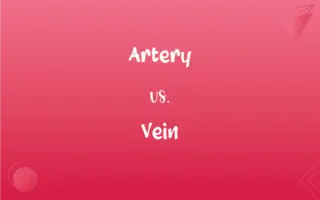OBD1 vs. OBD2: What's the Difference?
Edited by Aimie Carlson || By Harlon Moss || Updated on October 9, 2023
OBD1 is an earlier vehicle diagnostic system, while OBD2, standardized in 1996, offers enhanced diagnostics and monitoring.

Key Differences
OBD1, which stands for On-Board Diagnostics 1, is the initial version of the car diagnostic interface. In contrast, OBD2 (On-Board Diagnostics 2) is its successor, offering advanced capabilities.
Vehicles equipped with OBD1 systems typically have a unique setup for each manufacturer. However, OBD2 provides a more standardized approach to diagnostics, applicable across various car brands.
OBD1 systems primarily focus on engine performance and emission controls. OBD2, on the other hand, offers a comprehensive view, including real-time data and advanced diagnostic trouble codes (DTCs).
A key distinction lies in the compatibility of tools: OBD1 requires brand-specific tools, while OBD2 diagnostic tools are generally universal across most modern vehicles.
One can trace the shift from OBD1 to OBD2 back to increasing environmental regulations. OBD2 was essentially introduced to monitor vehicle emissions more closely and ensure environmental compliance.
ADVERTISEMENT
Comparison Chart
Time of Introduction
Early '80s to mid-'90s
Standardized in 1996
Standardization
Manufacturer-specific
Universal standard
Diagnostic Focus
Mainly engine and emissions
Comprehensive, including real-time data and advanced DTCs
Diagnostic Tool Compatibility
Brand-specific tools
Universal diagnostic tools for most vehicles
Environmental Compliance
Basic emission controls
Enhanced emission monitoring and compliance
ADVERTISEMENT
OBD1 and OBD2 Definitions
OBD1
Manufacturer-specific diagnostic interface.
Diagnosing issues on OBD1 systems often required brand-specific tools.
OBD2
Offers real-time data and advanced DTCs.
OBD2 scanners provide real-time metrics like fuel efficiency and engine temperature.
OBD1
Predecessor to OBD2 in vehicle diagnostics.
OBD1 systems were prevalent before the introduction of OBD2 in 1996.
OBD2
Provides a comprehensive vehicle health overview.
With an OBD2 system, drivers can get insights into nearly every aspect of their vehicle's health.
OBD1
Less advanced diagnostic capabilities than OBD2.
Technicians often found OBD1 limited in diagnosing intricate car issues.
OBD2
Standardized car diagnostic system introduced in 1996.
All cars post-1996 in the US are equipped with OBD2 systems.
OBD1
Initial car diagnostic system.
His older car still operates on an OBD1 system.
OBD2
Universal diagnostic interface across modern vehicles.
A single OBD2 scanner can diagnose issues in various car brands.
OBD1
Primarily focused on engine and emission diagnostics.
OBD1 could detect essential emission failures, but not as comprehensively as OBD2.
OBD2
Enhanced emission monitoring for environmental compliance.
OBD2 systems help ensure cars meet stringent emission standards.
FAQs
Are modern cars equipped with OBD1 or OBD2?
Modern cars, especially those post-1996 in the US, come with OBD2 systems.
What's the primary purpose of OBD2?
OBD2 offers comprehensive vehicle diagnostics, especially focusing on emission monitoring and compliance.
When was OBD2 standardized?
OBD2 was standardized in 1996.
Can I use OBD2 tools for OBD1 systems?
Generally, no. OBD1 systems often require brand-specific diagnostic tools.
Can OBD2 detect non-engine related issues?
Yes, OBD2 can diagnose a broader range of issues beyond just the engine.
Why was there a transition from OBD1 to OBD2?
The transition was largely due to increased environmental regulations and the need for enhanced diagnostics.
What type of connector does OBD2 use?
OBD2 typically uses a standardized 16-pin connector.
How do OBD systems aid mechanics?
They provide diagnostic codes and data that indicate specific vehicle issues, aiding in troubleshooting.
Are OBD2 codes the same across all car brands?
While many OBD2 codes are standardized, manufacturers might have specific codes unique to their vehicles.
Can OBD1 systems monitor real-time vehicle data?
OBD1 systems are limited in this capacity, while OBD2 offers extensive real-time monitoring.
How do OBD systems affect car resale value?
Cars with a clear OBD report indicating no significant issues can have a higher resale value.
Is OBD2 a global standard?
While widely adopted, specifics might vary by country. In the US, it became a standard in 1996.
What does OBD1 stand for?
OBD1 stands for On-Board Diagnostics 1, an initial vehicle diagnostic system.
Where is the OBD port typically located?
It's often found under the dashboard, near the driver's seat.
Can I use an OBD2 scanner on my own?
Yes, many OBD2 scanners are user-friendly, allowing car owners to diagnose basic vehicle issues.
Is OBD2 only about emission control?
While emission control is a primary focus, OBD2 offers a comprehensive overview of vehicle health.
How do OBD systems impact the environment?
By monitoring emissions and ensuring compliance, they help reduce the environmental impact of vehicles.
Are there any successors to OBD2?
As of now, OBD2 remains the standard, but advancements in vehicle tech might lead to new diagnostic systems in the future.
Can OBD systems improve driving habits?
They provide data that can inform drivers about fuel efficiency and other factors, potentially promoting better driving habits.
Can I upgrade my OBD1 system to OBD2?
It's complex and often not feasible due to hardware and software differences. Specific kits are available, but compatibility isn't guaranteed.
About Author
Written by
Harlon MossHarlon is a seasoned quality moderator and accomplished content writer for Difference Wiki. An alumnus of the prestigious University of California, he earned his degree in Computer Science. Leveraging his academic background, Harlon brings a meticulous and informed perspective to his work, ensuring content accuracy and excellence.
Edited by
Aimie CarlsonAimie Carlson, holding a master's degree in English literature, is a fervent English language enthusiast. She lends her writing talents to Difference Wiki, a prominent website that specializes in comparisons, offering readers insightful analyses that both captivate and inform.






































































